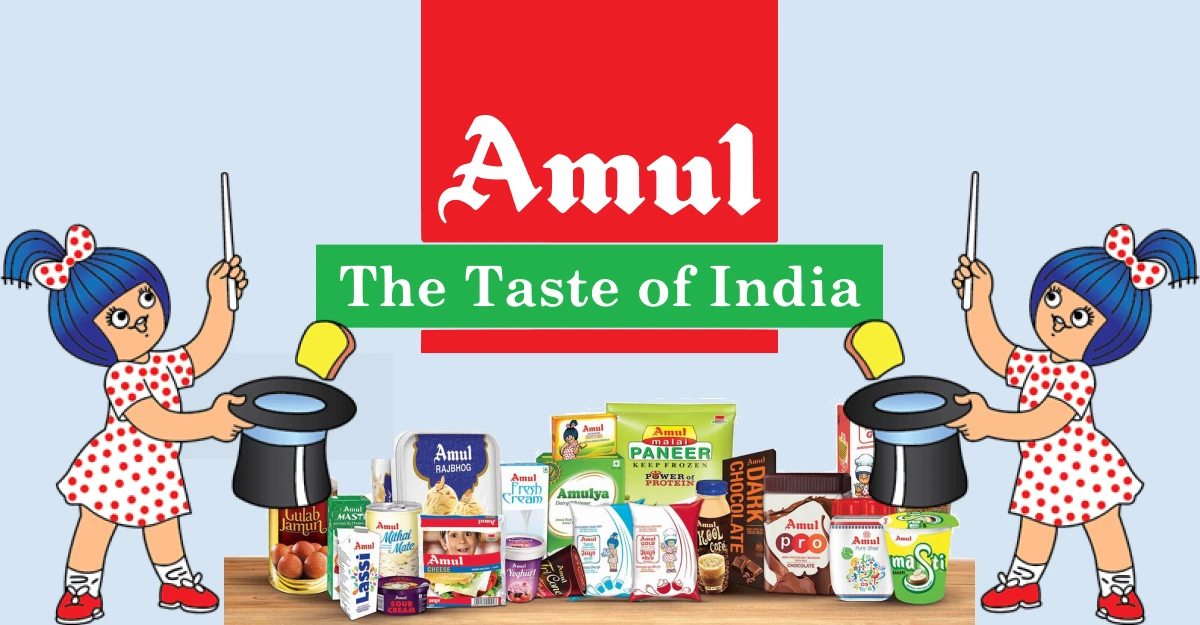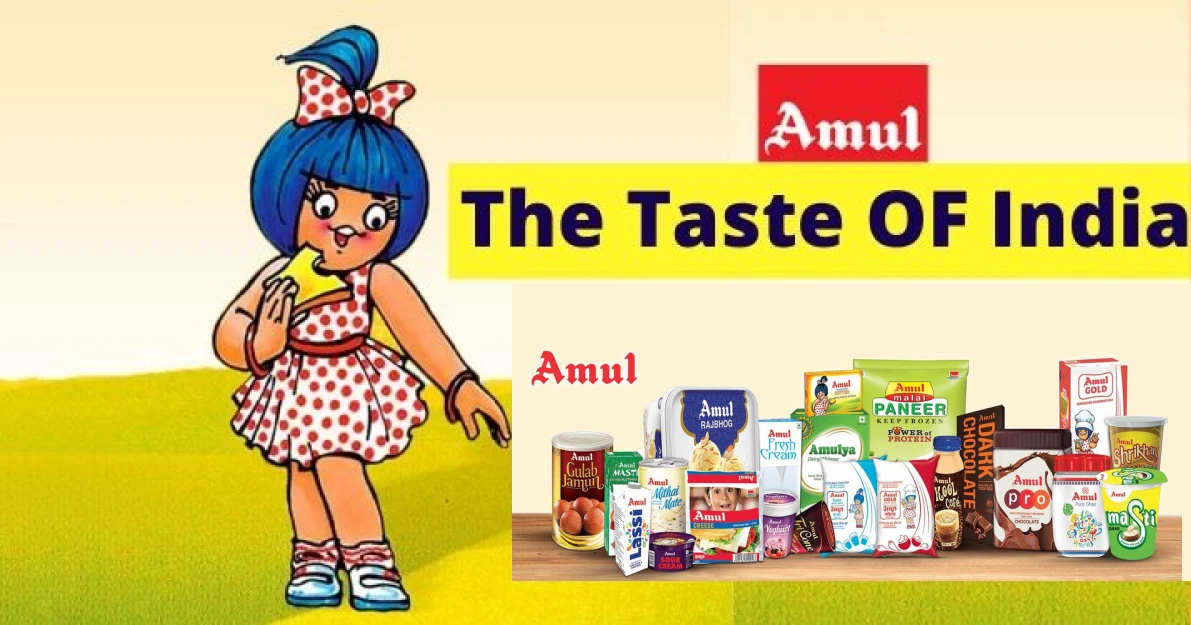Brands go through tough competition to be in the limelight. But certain brands rule the era with their exclusive product and efficient marketing. One such brand is AMUL! Established in 1946 by Dr.Verghese Kurein, AMUL is still ruling the dairy and FMCG industry. Who knew that a brand established at the time of Indian Independence will still be prevalent and famous? But to your surprise, Amul is neither a private company nor a public entity! Really? Isn’t it a brand? Yes, it is but not a company. It is a cooperative society started by Dr.Verghese Kurein in 1946 named Anand Milk Union Limited. At that time, it aimed to provide justice to farmers. We will delve into its history later. But for now, let’s focus on Amul marketing strategy.

History of Amul Marketing Strategy
First of all, let’s delve into Amul’s ad history in brief. Dr.Vargese Kurien was a far-sighted person. He knew that a strong brand identity is crucial to stand out in the FMCG market. But he wasn’t an expert in the field of marketing/advertising. Therefore, he handed the responsibility for Amul’s advertisements to Sylvester da Cunha in 1966. The team of Sylvester created and conceptualized this iconic Amul girl with a tagline- “Utterly butterly delicious.” This tagline was made for Amul butter.

Don’t you wonder- What was the need to use such a high level of creativity back in 1966-67? Because back then Amul had to fight a well-established player of that time. That was- “Polson”. The company Polson was quite successful in those days. Also, it was a strong rival of Amul.
Before moving further compare the two girls given in the following picture-

As you can see, Polson’s ad girl was soft, calm, and kind. She made Polson very popular in those days. So, instead of copying Polson’s calm & soft ad girl, Sylvester da Cunha did the exact opposite. He created a mischievous and smart little girl who digs into every current event in the country. Cunha’s concept was to portray the generic curious nature of little children. And his plan was a grand success! Amul’s girl caught the public’s attention effectively and successfully contributed to moment marketing strategies. We will explain it in the upcoming sections.
Note: You will get detailed information on Amul’s journey and its battle with Polson in the article- “Amul Case Study.”
Target Audience of Amul
Before we delve into the different types of Amul’s marketing strategy, we need to understand the target audience of the brand. As you know, marketing strategies are designed based on your target audience. Similar is the case with Amul. This section will help you to easily understand the upcoming sections. Amul has two types of target audiences-
1. Direct Consumers

Can you recall when you saw the advertisement for Amul for the first time? Maybe you won’t remember! Because we have been seeing it since childhood. If you are a millennial or Gen-Z, then I am sure you would have seen the ads of Amul. Especially on billboards, newspapers, radio, as well as on television. Amul has always been creative when it comes to creating advertisements. It created advertisements for every age group depending on their interests and choices. Those advertisements are basically for direct consumers i.e. for B2C (Business to Consumers) segment.
Some of them are-
- Children: Milk, Chocolate, dairy drinks (Amul Kool), Lassi, etc.
- Adults: Butter, Ghee, Cheese Spread, Pizza Cheese, etc.
- Diet Followers: Skimmed milk, low-fat butter, etc.
2. Retailers

Apart from direct consumers, Amul also sells its products to wholesalers and retailers. Do you know Amul is ruling the market through its B2B (Business-to-Business) category? Those retailers buy Amul products in bulk regularly. Do you know Amul also supports franchises? The profit margin on Amul products is-
- Pouch Milk: 2.5%
- Ice Cream: 20%
- Milk Products: 10%
- Recipe categories (Ice-cream scoops, baked pizza, etc.): 50%
Amul Marketing Strategy
There are numerous dairy companies in India. But AMUL (cooperative society) stands out in this competition. Why? You may ask. Due to its innovative marketing strategies. If you observe, then you will find that Amul dominated this cut-throat competition with its creative marketing campaigns. So, let’s dive into it-
1. Amul’s Ad Little Girl
Look at the picture below-

Do you know this girl? Of course, you do. After all, who doesn’t know Amul’s girl? This was a handmade drawing of a girl with a coconut ponytail on her head. Also, we discussed in the above section how this concept was created back in 1967. This is the oldest ad campaign of Amul which is still loved by many of us.
Be it butter or cheese spread, you will find her in the majority of Amul products. There are innumerable examples where Amul catches the attention of the audience with this 56-year-old little girl. Sounds quite ironic. Right? Her attire changes as per the festivity. During IPL or cricket world cups, she plays cricket by wearing an Indian jersey. At the time of health awareness or National Yoga Day, she does different poses of Yoga. During Holi, she plays with colors. Well, this is a part of moment marketing. Look at the next section to know more about it.
2. Moment Marketing
This is an impactful marketing technique where the brand targets the customers at the moment it matters. These marketing campaigns are relevant and spontaneous. Amul has been using a moment marketing strategy ever since the past fifty years. Let’s look into some of them-
New Year 2023

Neeraj Chopra’s javelin throw

Data Breaches

Elon Musk- the wealthiest man

Vaccination for young adults

3. Word of Mouth Marketing
This is the most powerful as well as efficient marketing strategy. Not only it contributes to a good brand reputation but also guarantees purchases (Conversion Rates). And how did Amul achieve it? By offering good quality products. You can also call it a low-cost & high-value marketing strategy. As you know, the majority of Indians belong to the middle class or lower middle class. They prefer good quality products at affordable prices. Therefore, setting a reasonable price has proved to be beneficial for Amul to target a mass market. You might have seen that FMCG companies sell products under different brand names. But Amul sells all of its products under the same name.
4. Alluring Taglines
Do you know taglines are the soul of advertisements? When your tagline is powerful, it encourages the customers to purchase your product/service. And when it comes to taglines, you will hardly find any brand that competes with Amul! Some of the famous taglines/slogans of Amul ads are-
- Amul- The Taste of India
- Amul Doodh Pita hai India
- Utterly butterly delicious- Amul
- Bun Tea Aur Butterly!
- Pizzadent Obama: Amul, Perfect topping
- Kaun Banega Rashtrapati? Amul: Head of taste
- Modijeet! Amul, Taste of Victory
- Holi masti, wholly Maska! Amul: khilao, peela, Lao!
- Ronaldo, Rivaldo, Amul Do
5. Umbrella Branding/ Family Branding

This is the ultimate secret of Amul’s marketing strategy. When you sell all of your products under one brand, then it is called “Umbrella Branding” or “Family Branding.” This means all the products like milk, butter, curd, chocolates, cheese, and ice cream, belong to one family i.e. AMUL. Whenever Anand Milk Union Limited (AMUL) launches a new product, its sales boost and sell out seamlessly. Why? Because it is part of Amul and got the advantage of Amul’s brand value.
Let me tell you another interesting fact about Amul’s umbrella marketing strategy! This strategy comprises & utilizes all of the above strategies like a little girl, alluring taglines, moment marketing, etc. As a result, Amul has to spend hardly 1% of its total sales on ads. This not only reduces the expenditure but also contributes to effortless advertisements of Amul’s newly launched products.
6. Digital Marketing

For a successful running of an organization, you need to upgrade yourself with time. Amul left no stone unturned when it came to a competitive digital world. It means that it utilized the digital marketing technique effectively to have a strong foothold in the market. As you know, digital marketing is quite cheaper than traditional marketing. Thus, it conferred high-profit margins to Amul.
Some of the significant digital marketing strategies used by Amul are-
- SEO Strategy: Amul’s website gets approx. 1 million visitors per month.
- Social Media Marketing Strategy: Amul has high followers on social media platforms like Facebook, Instagram, Twitter, etc.
- Content Marketing: Amul uploads simple home recipes on its official YouTube channel. It has over 4 lac subscribers and the recipes are taught by professional chefs.
Final Words: What is Amul’s secret sauce for advertising?

By now you must have realized that Amul became an advertising icon despite spending only 1% of its sales on advertisements. This may sound too good to be true but it is real! This expenditure is far much less than other FMCG companies like Britannia, Dabur, or Godrej. Do you know how much it earned in FY22? Rs.61,000 crore ($7.6 billion). On a five-year basis, its average expenditure on ads is hardly 0.8% of its revenue. All of the credit goes to umbrella branding! Thus, its secret sauce for advertising is an umbrella branding/family branding strategy. Also, it includes moment marketing, alluring taglines, digital marketing, and our favorite Amul’s little girl!


I would say the company has successfully captured new market segments by creating new products. It is also important to note that the company has adopted robust marketing strategies for different market segments. For example, it has created a number of value-based products for the mass market while focusing on the premium segment for its premium products.